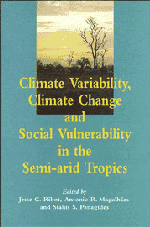Book contents
- Frontmatter
- Contents
- List of contributors
- Foreword by Tom Downing
- Preface
- List of abbreviations
- Introduction. Climate Variability, Climate Change and Vulnerability: Moving Forward by Looking Back
- PART I OVERVIEW
- PART II CLIMATE VARIATION, CLIMATE CHANGE AND SOCIETY
- PART III CLIMATE VARIABILITY AND VULNERABILITY: CAUSALITY AND RESPONSE
- 6 Drought Follows the Plow: Cultivating Marginal Areas
- 7 Amazonia and the Northeast: The Brazilian Tropics and Sustainable Development
- 8 Reducing the Impacts of Drought: Progress Toward Risk Management
- PART IV THE INTERNATIONAL CONFERENCE ON THE IMPACTS OF CLIMATIC VARIATIONS AND SUSTAINABLE DEVELOPMENT IN SEMI-ARID REGIONS (ICID)
7 - Amazonia and the Northeast: The Brazilian Tropics and Sustainable Development
Published online by Cambridge University Press: 02 December 2009
- Frontmatter
- Contents
- List of contributors
- Foreword by Tom Downing
- Preface
- List of abbreviations
- Introduction. Climate Variability, Climate Change and Vulnerability: Moving Forward by Looking Back
- PART I OVERVIEW
- PART II CLIMATE VARIATION, CLIMATE CHANGE AND SOCIETY
- PART III CLIMATE VARIABILITY AND VULNERABILITY: CAUSALITY AND RESPONSE
- 6 Drought Follows the Plow: Cultivating Marginal Areas
- 7 Amazonia and the Northeast: The Brazilian Tropics and Sustainable Development
- 8 Reducing the Impacts of Drought: Progress Toward Risk Management
- PART IV THE INTERNATIONAL CONFERENCE ON THE IMPACTS OF CLIMATIC VARIATIONS AND SUSTAINABLE DEVELOPMENT IN SEMI-ARID REGIONS (ICID)
Summary
INTRODUCTION
This paper examines the history of the relationship between Brazil's semi-arid Northeast and the tropical North, commonly known as the Amazon region.* The comparison provides a basis for a broader discussion of the possibilities for and constraints on sustainable development in the Amazon. The impetus for this study came from two sources. First, there is increasing international attention on development in the Amazon, and second, the Amazon and Northeast regions of tropical Brazil are becoming progressively more interdependent. Hence, it is time to question whether the scope of the present deliberations on the Amazon should be widened and placed within the context of the region's relations with neighboring states as well as the political economy of national development policy.
This study examines the roles played by the Northeast and the Amazon in the recent history of national development, and investigates the repercussions of changes in Brazilian society on people's perceptions of these geographic regions and of space in general. In particular, the chapter looks at the social and environmental impacts of changing development policies and associated demographics in the Amazon Region. The analysis focuses on the last 30 years with references to earlier periods.
In the first section of the chapter, we discuss the historical background of the perception that the two regions are peripheral to national development. Next the Northeast and the Amazon are placed within their national context, focusing particularly on the economic and social processes defining them as distinct regions. In the third section we explore the social and environmental impacts resulting from these distinctions.
- Type
- Chapter
- Information
- Climate Variability, Climate Change and Social Vulnerability in the Semi-arid Tropics , pp. 129 - 146Publisher: Cambridge University PressPrint publication year: 1996



